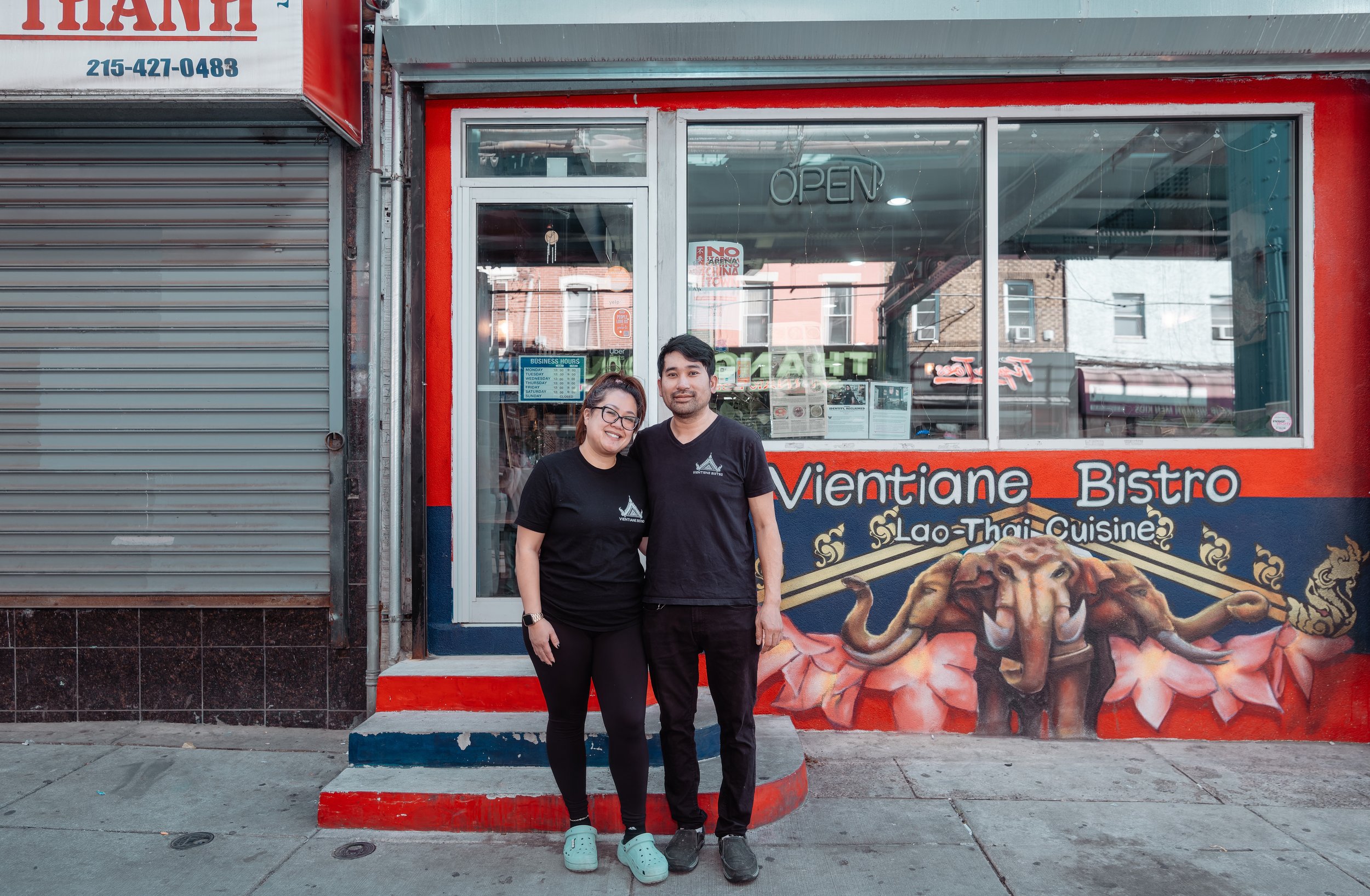
GENERATIONS
UNDER THE EL
For generations, Kensington has been a place where immigrant and working-class Philadelphians have been able to build a life for themselves and their families.
Kensington’s textile industry of the 19th Century grew from a network of small firms and factories that provided yarns to workers who hand loomed goods in their homes. Those small businesses gave rise to a manufacturing industry the scale of which surpassed anything the world had ever seen at the time. Hundreds of mills and factories rose in Kensington, generating thousands of jobs and lining the neighborhood’s residential blocks with two story brick row homes where workers and their families lived.
New residents—many of whom immigrated from Ireland, Scotland, England, Germany and other parts of Europe—arrived in the neighborhood, finding a place where they could live affordably, work, and raise their children. These immigrants contributed to the neighborhood’s unique working-class culture and character. They also spurred innovation and created a market for small businesses such as grocery stores, delis, pubs, tailors, bakeries, barber shops, retail and specialty stores, banks and more to emerge along Kensington Ave and the neighborhood’s other commercial corridors.
Over the years, families have continued to come to Kensington from places all over the world in search of opportunity. The Great Migration and Operation Bootstrap brought many African American and Puerto Rican families to the neighborhood in the mid-20th Century. In the decades since, small business owners in Kensington have also come from places including Cambodia, China, the Dominican Republic, India, Korea, Laos, Mexico, Poland, Senegal and Vietnam. These entrepreneurs and their families have invested everything they have into their businesses and the neighborhood to build new opportunities for themselves and future generations.

Small Business Owners in Kensington Today
Many of the business owners operating in Kensington today are immigrant entrepreneurs that have lived and worked in the neighborhood for many years. They arrived in Philadelphia in the 1980s, 1990s, and early 2000s, following the decline of major industry in the city. Family and friend connections brought them to Kensington. Where others saw only vacancy and blight at the time, these entrepreneurs recognized opportunity in Kensington’s empty and affordable commercial storefronts. In some cases, business owners even began on the street, selling goods like produce, flowers, toys and t-shirts out of sidewalk stands before they were either able to purchase a business or scale what they were doing into storefront operations.
Throughout the 1990s and early 2000s, these entrepreneurs and their families mastered skills and built community. Job opportunities were scarce and access to capital was limited, but they lived frugally, worked diligently, and relied on family and neighbors for support. They mastered trades like jewelry cutting, nail artistry, vehicle maintenance and appliance repair, and opened produce stores, restaurants, and retail shops that sold workwear, sports apparel and school uniforms. Providing quality products and services at an affordable price while fostering close-knit relationships with their working-class clientele was key to the success of their businesses.
More than two decades later, many of these businesses still remain. They have outlasted competition from big box competitors, endured all the challenges that have come with operating a business in Kensington, and witnessed many businesses open and close around them. While profit margins are often tight, business owners have earned enough to send their children to school and help them access greater economic opportunity. In many cases, those children now help their parents manage their businesses.
But circumstances have evolved. Kensington Avenue, Front Street, and other commercial corridors in the neighborhood are no longer what they once were. The deterioration of physical infrastructure, rise of vacancy rates, and challenges such as crime and open-air drug trade have significantly reduced foot traffic. Retail sales have consolidated under tech giants like Amazon, while competition from the digital marketplace has also negatively impacted businesses like nail and beauty salons.
As nearby neighborhoods like Fishtown and Northern Liberties have undergone rapid transformation due to private development in recent years, pressures of gentrification encroach on Kensington. Despite worsening conditions outside their businesses, business owners have seen commercial property values, taxes, and rent rates rise substantially. These very business owners who have shaped Kensington into what it is today now face an urgent threat of displacement.
Photographs by Thanh Nguyen












Resilience, Connection and Paths Forward
Despite the challenges, there is plenty of hope for Kensington’s small business community and much to build upon.
Kensington’s walkable commercial corridors and close proximity to the Market-Frankford El make the neighborhood a highly accessible and attractive location to own a business. Improved safety and cleanliness along the Market-Frankford El and Kensington’s sidewalks remain a universal priority among business owners in the area.
Business owners surveyed by NKCDC have also expressed a desire for improvements to the neighborhood’s aging infrastructure. Enhancements such as improved lighting along commercial corridors, sidewalk repairs, and upgraded stormwater infrastructure would make walking through the neighborhood safer and more accessible for residents and shoppers alike. Additionally, activating vacant lots along these corridors could significantly increase safety, vibrancy, and community connection.
Many commercial storefronts throughout Kensington are in need of repairs. Facade renovations and new signage would greatly benefit numerous businesses, but deeper structural issues often take precedence. In particular, many commercial and mixed-use properties in Kensington require roof repairs and improved weatherization. Issues such as leaks and water damage not only impose financial burdens on business owners but also hinder these properties from housing residents who could contribute to increased foot traffic and economic activity along the neighborhood’s commercial corridors.
To meet eligibility requirements for many city and state-funded programs that could subsidize the costs of these repairs, business owners will need to formalize their accounting and bookkeeping methods. Many businesses in Kensington operate within an informal, cash-based economy. Back-end support from local, reliable, and culturally informed accountants could help these business owners organize their financial records. This support would enable them to apply for opportunities such as the city’s Storefront Improvement Program, enhance their applications for the Philadelphia Business Lending Network’s Incentive Grant, and cultivate stronger relationships with CDFIs and banks, ultimately providing the capital needed for long-term growth.
Connecting business owners with the resources they need to establish an online presence, advertise their services on social media, and sell products in the digital marketplace will enable them to grow and remain competitive in the 21st-century economy. Local tech talent can help business owners to share their stories online, reimagine their branding, engage with new audiences, and expand their customer base. Legal assistance can also guide business owners through zoning issues related to their commercial properties and help ensure they are positioned for success with responsible lease agreements, whether they are long-established businesses or new shops along the corridor.
Ultimately, the solutions to creating a safer, healthier, and more economically vibrant Kensington are complex. These issues cannot be addressed solely through economic development strategies and tools. They are deeply interconnected with the broader challenges facing the neighborhood, related to poverty, systemic racism, housing, community health, education, and safety. At the heart of these solutions, however, are the individuals and families behind Kensington’s small businesses. Long-term residents and newcomers from countries around the world that have invested all they have into the growth and well-being of this neighborhood.
Kensington’s legacy of resilience and ingenuity is evident in long-standing businesses like Morris Auto Parts and Martin’s Deli, that have operated on Kensington Avenue for over a century. It is also reflected in more recent additions to the neighborhood like Cantina La Martina, Flip Out Gymnastics and Vientiane Bistro. Together, these small businesses and the families behind them embody the enduring spirit of Kensington’s past and play a central role in shaping the neighborhood’s promising future.
Explore the accompanying exhibit at the Kensington Engagement Center
Reach out at engagementcenter@nkcdc.org to schedule a group visit. Learn more about the Kensington Engagement Center here: Kensington Engagement Center